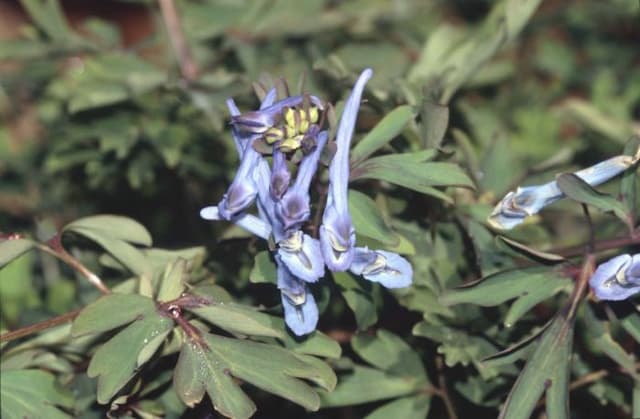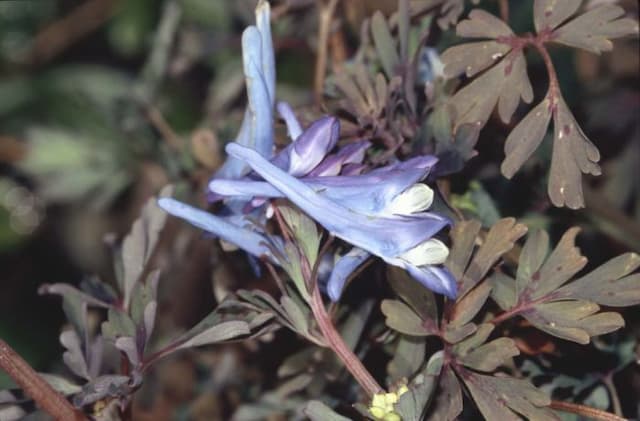Double Bloodroot Sanguinaria canadensis f. multiplex (d)

ABOUT
The plant commonly known as the double bloodroot is a fascinating species with a unique and striking appearance. This variation is particularly noted for its ornate flowers, which are a distinctive feature setting it apart from the more commonly seen single-petaled variety. The blooms are composed of numerous white petals that create a fuller, more intricate look akin to a lush, frilly rosette. This elaborate floral display gives the double bloodroot a certain aesthetic appeal that is cherished by gardeners and plant enthusiasts. In contrast to the flamboyant flowers, the leaves are relatively simple yet no less elegant. Each leaf, emerging on its own stem, unfolds like a shroud to reveal the flower nestled within. These leaves are generally lobed and have a circular or kidney shape, offering a soft green backdrop that emphasizes the purity of the white petals. As the plant matures through its brief life cycle, the leaves can grow quite large, adding to the visual impact of the foliage. The roots of this plant, which give it its common name, contain a rich red sap. This sap has been historically noteworthy for its use as a dye and is a characteristic trait of the species. It contrasts sharply with the cleanliness of the white flowers, hiding just beneath the surface of the soil in which the plant grows. The entire plant would present an enchanting sight when in full bloom and would undoubtedly be a conversation starter in any garden setting due to its rare and captivating double-flowered form.
About this plant
 Names
NamesFamily
Papaveraceae
Synonyms
Double Bloodroot, Multiplex Bloodroot
Common names
Sanguinaria canadensis var. multiplex (D. C. Eaton) Ownbey, Sanguinaria canadensis f. plena.
 Toxicity
ToxicityTo humans
Bloodroot contains toxic compounds, particularly sanguinarine, which can have harmful effects if ingested. Ingesting bloodroot can cause nausea, vomiting, dizziness, fainting, and in severe cases, it can lead to respiratory failure and death. Topical application of the plant has also been associated with tissue necrosis.
To pets
Bloodroot is toxic to pets, as it contains compounds that can be harmful if ingested. Symptoms of poisoning in pets may include vomiting, lethargy, and diarrhea. Ingesting a substantial amount could potentially result in collapse, difficulty breathing, and, in extreme cases, death due to the same toxic mechanism it has in humans.
 Characteristics
CharacteristicsLife cycle
Perennials
Foliage type
Deciduous
Color of leaves
Green
Flower color
White
Height
6 inches (15 cm)
Spread
1 foot (30 cm)
Plant type
Herb
Hardiness zones
3
Native area
North America
Benefits
 General Benefits
General Benefits- Eco-friendly – Sanguinaria canadensis f. multiplex, commonly known as double-flowering bloodroot, is a native plant that supports local ecosystems and adapts well to its regional climate.
- Attractive flowers – It produces distinctive white double flowers that add visual interest and aesthetic value to gardens and naturalized areas.
- Pollinator-friendly – The plant's flowers attract pollinators such as bees and butterflies, which play a critical role in the pollination of many plants and crops.
- Low maintenance – Once established, double-flowering bloodroot requires minimal care, making it suitable for gardeners looking for low-maintenance options.
- Natural groundcover – It can effectively function as a groundcover, helping reduce weed growth and soil erosion in shaded areas.
- Education and research – This variant of bloodroot offers opportunities for educational programs and botanical research related to plant reproduction and horticulture.
- Cultural significance – Double-flowering bloodroot has been valued by various cultures and can serve as a plant of interest for cultural and historical studies.
- Ecological balance – By incorporating native plants like double-flowering bloodroot into landscapes, gardeners can help maintain biodiversity and ecological balance.
 Medical Properties
Medical Properties- Antimicrobial: Sanguinaria canadensis, commonly known as bloodroot, contains the alkaloid sanguinarine which has been found to possess antimicrobial properties.
- Expectorant: It has been traditionally used to help expel respiratory secretions.
- Emetic: The plant has emetic properties, causing vomiting when ingested in sufficient quantities.
- Plaque-inhibiting: Sanguinarine from bloodroot has been used in certain toothpastes and mouthwashes to inhibit plaque formation.
- Antiplaque: Similarly due to sanguinarine, it has been used to reduce dental plaque accumulation.
- Anticancer potential: There have been some studies suggesting that sanguinarine could have anticancer properties, but this use is not well established, might be unsafe, and should not be considered a recommendation for treatment.
 Air-purifying Qualities
Air-purifying QualitiesThis plant is not specifically known for air purifying qualities.
 Other Uses
Other Uses- Dye Production: The roots of Sanguinaria canadensis, commonly known as bloodroot, contain a red pigment which has been used historically as a dye for textiles and body paint.
- Insecticide: Bloodroot extracts have been used as an insect repellent and insecticide, especially in organic gardening practices.
- Gardening: Bloodroot is valued for its ornamental features, with its unique double or "multiplex" form being a sought-after variety for shade gardens.
- Photography: The plant's distinctive sap has been historically used in the "plant photography" process to create images on paper and textiles.
- Symbolism: In native cultures and modern spiritual practices, bloodroot is often used symbolically to represent protection and love.
- Traditional Ceremonies: Indigenous tribes have used bloodroot for ceremonial purposes, including as part of ritual body painting.
- Eco-friendly Pest Control: The natural compounds found in bloodroot make it useful as a component in non-toxic pest control formulations.
- Botanical Illustration and Education: Bloodroot is a popular subject in botanical art, used for educational purposes to teach about plant structures and life cycles.
- Soil Erosion Control: Bloodroot plants, through their root systems, can contribute to stabilizing soil and preventing erosion in shaded areas where they are native.
- Cultural Heritage Preservation: Due to its traditional uses by Native Americans, cultivating bloodroot can play a role in preserving cultural heritage and ethnobotanical knowledge.
Interesting Facts
 Feng Shui
Feng ShuiThe Bloodroot is not used in Feng Shui practice.
 Zodiac Sign Compitability
Zodiac Sign CompitabilityThe Bloodroot is not used in astrology practice.
 Plant Symbolism
Plant Symbolism- Life and Death: Sanguinaria canadensis, also known as bloodroot, has a red sap that resembles blood, symbolizing both the life force and mortality.
- Healing: Historically used by Native Americans for medicinal purposes, bloodroot represents the healing power of nature.
- Hope and Renewal: As a spring ephemeral, bloodroot symbolizes new beginnings and the hope that comes with the arrival of spring.
- Protection: Bloodroot was often used in folk medicine to create protective charms, symbolizing safety and warding off evil spirits.
- Purity: The stark white flowers of the bloodroot plant symbolize purity and innocence.
 Water
WaterThe Double Bloodroot should be watered once every week or two, allowing the soil to dry out slightly between waterings. During the active growing season in spring and early summer, it'll appreciate more frequent watering, approximately half a gallon per week depending on soil conditions and climate. In the dormant season, reduce watering to once every two to three weeks with a quarter gallon, as the plant requires less moisture.
 Light
LightFor Double Bloodroot, a spot that provides partial shade to dappled sunlight is ideal. They thrive in light conditions that mimic their natural woodland habitat, avoiding full, direct sun which can scorch their delicate leaves. East or north-facing gardens would provide the optimal light conditions for these plants.
 Temperature
TemperatureDouble Bloodroot grows best in temperatures that typically range from 50°F to 70°F. It can withstand minimum temperatures down to about 20°F, and while it can survive occasional highs up to 90°F, prolonged heat can be detrimental. Ideal conditions are within the aforementioned range, where the plant can grow and bloom effectively.
 Pruning
PruningPruning Double Bloodroot is not typically necessary for health or growth but can be done to remove dead or damaged foliage. Pruning should be done after flowering, in late spring or early summer. Deadheading the spent flowers can encourage a tidy appearance, and occasional thinning may promote air circulation.
 Cleaning
CleaningAs needed
 Soil
SoilThe best soil mix for Bloodroot (Sanguinaria canadensis f. multiplex (d)) is a well-draining, rich, loamy soil with a pH of 5.5 to 6.5. Incorporating compost or leaf mold can improve soil fertility and structure, benefiting the plant's growth.
 Repotting
RepottingBloodroot typically does not require frequent repotting; repotting every 2-3 years is adequate. However, it is essential to monitor the plant and repot as necessary if it outgrows its container or the soil becomes depleted.
 Humidity & Misting
Humidity & MistingBloodroot thrives in moderate humidity levels, consistent with its native woodland environment. Aim to maintain humidity levels between 40-60% for optimal growth.
 Suitable locations
Suitable locationsIndoor
Place in filtered light, keep soil moist, replicate woodland conditions.
Outdoor
Plant in partial shade, moist, well-drained soil, shelter from wind.
Hardiness zone
3-8 USDA
 Life cycle
Life cycleSanguinaria canadensis f. multiplex, commonly known as double-flowered bloodroot, begins its life cycle as a seed, typically dispersed by ants through myrmecochory, which then germinates in late spring or early summer. After germination, a small rhizome forms, and a singular, round, lobed leaf emerges, followed by a white, double-petaled flower that blooms in early spring, often before the forest canopy fully develops. After pollination, which is mostly by bees, the petals fall away and the leaf enlarges, photosynthesizing throughout the spring and summer to store energy in the rhizome. As summer progresses, the plant enters a dormancy phase where the above-ground parts die back, and the plant survives underground with the energy reserves in the rhizome. Throughout dormancy in fall and winter, the perennial bloodroot experiences cold stratification, which is essential for the seeds to break dormancy. The cycle recommences in the next spring when temperature and moisture conditions are favorable for the emergence of the next generation of flowers and leaves.
 Propogation
PropogationPropogation time
Spring
Bloodroot, known botanically as Sanguinaria canadensis f. multiplex, is often propagated via division, usually done in the fall. To propagate by division, carefully lift the bloodroot clumps from the soil, ensuring you have a segment of rhizome with at least one bud. Gently separate the clumps by hand or with a knife if necessary. The divisions can then be replanted in a shady area with rich, well-draining soil at the same depth they were growing previously. Space the divisions approximately 6-12 inches apart (about 15-30 centimeters), keeping the soil moist until the plant is established. This method allows for the quick establishment of new plants and is favored by gardeners for its simplicity and effectiveness.









